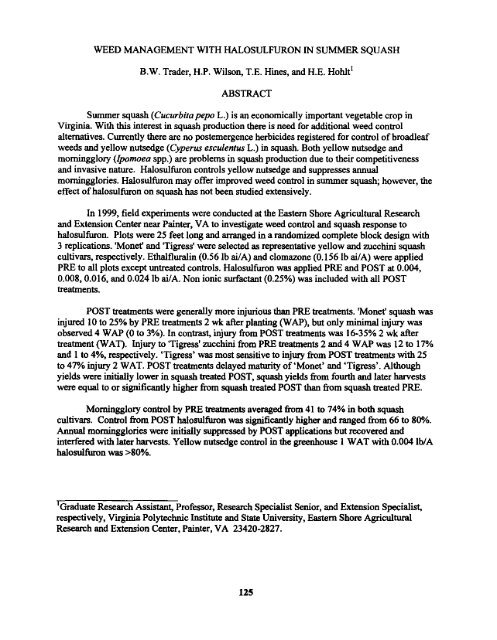Vol. 54â2000 - NorthEastern Weed Science Society
Vol. 54â2000 - NorthEastern Weed Science Society
Vol. 54â2000 - NorthEastern Weed Science Society
Create successful ePaper yourself
Turn your PDF publications into a flip-book with our unique Google optimized e-Paper software.
WEED MANAGEMENT WITH HALOSULFURON IN SUMMER SQUASH<br />
B.W. Trader, H.P. Wilson, T.E. Hines, and H.E. HoWt!<br />
ABSTRACT<br />
Summersquash (Cucurbita pepo L.) is an economically importantvegetable crop in<br />
Virginia Withthis interestin squashproductionthereis need foradditionalweed control<br />
alternatives.Currentlythereareno postemergenceherbicidesregisteredfor controlof broadJeaf<br />
weeds and yellow nutsedge (Cyperus esculentus L.) in squash. Both yellow nutsedge and<br />
morningglory (Ipomoea spp.) areproblemsin squashproductiondueto theircompetitiveness<br />
andinvasivenature. Halosulfuroncontrolsyellow nutsedgeandsuppressesannual<br />
morningglories.Halosulfuronmay offer improvedweed controlin summersquash;however,the<br />
effect of halosulfuronon squashhasnot beenstudiedextensively.<br />
In 1999, field experiments were conducted at the Eastern Shore Agricultural Research<br />
andExtension CenternearPainter,VA to investigateweed controland squashresponse to<br />
haIosuifuron. Plots were 25 feet long and arranged in a randomized complete block design with<br />
3 replications.'Monet'and'Tigress'were selectedas representativeyellow andzucchinisquash<br />
cultivars, respectively. Ethalfluralin (0.56 Ib ai/A) and clomazone (0.156Ib ai/A) were applied<br />
PRE to all plots except untreated controls. Halosulfuron wasapplied PRE and POST at 0.004,<br />
0.008,0.016, and 0.0241b ai/A. Non ionic surfactant (0.25%) was included with all POST<br />
treatments.<br />
POSTtreatmentswere generallymoreinjuriousthanPREtreatments.'Monet'squashwas<br />
injuted 10 to 25% by PRE treatments 2 wk after planting (WAP), but only minimal injury was<br />
observed 4 WAP (0 to 3%). In contrast, injury from POST treatments was 16-35% 2 wk after<br />
treatment (WAT). Injury to 'Tigress' zucchini from PRE treatments 2 and 4 WAP was 12 to 17%<br />
and 1 to 4%, respectively. 'Tigress' was most sensitive to injuryfrom POST treatmentswith25<br />
to 47% injury 2 WAT. POST treatments delayed maturity of 'Monet' and 'Tigress'. Although<br />
yields were initially lower in squash treatedPOST, squash yields from fourth and later harvests<br />
were equal to or significantly higher from squash treated POST than from squash treated PRE.<br />
Morningg1ory control by PRE treatments averaged from 41 to 74% in both squash<br />
cultivars. Control from POST haIosuifuron was significantly higher and ranged from 66 to goolo.<br />
Annual momingglories were initially suppressed by POST applications but recovered and<br />
interfered with later harvests. Yellow nutsedge control in the greenhouse 1 WAT with 0.004 IbiA<br />
haIosuifuron was >gO%.<br />
'Graduate Research Assistant, Professor, Research Specialist Senior, and Extension Specialist,<br />
respectively, Virginia Polytechnic Institute and State University, Eastern Shore Agricultural<br />
Research and Extension Center, Painter , VA 23420·2827.<br />
125
















